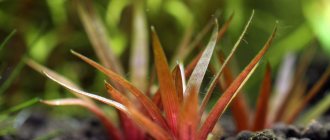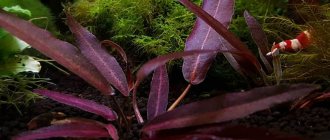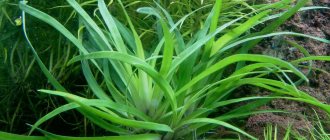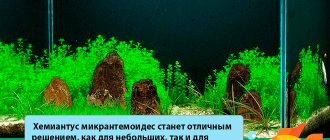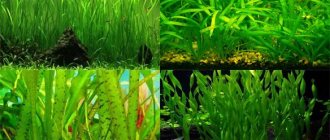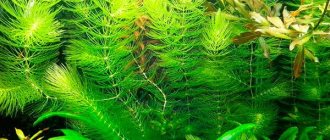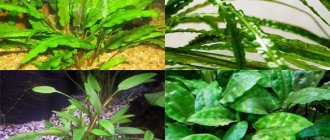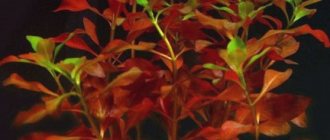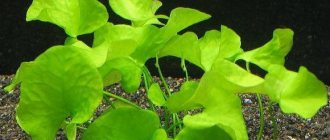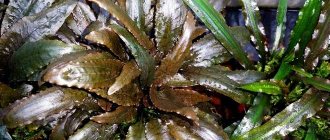This representative of the Eriocaulonaceae family is one of many plants that allow you to create designer aquariums. Great for reflecting tropical flora. It is also used in the organization of species aquariums, where it is adjacent to other plants from its family. Or used in mixed compositions to separate the foreground, middle and background of the landing.
Growing and care
Eriocaulon sp. Vietnam is considered less demanding in terms of care compared to other members of the Eriocaulonidae family. However, it remains quite difficult to grow. On the other hand, observing the conditions for keeping the plant in the aquarium increases the chances of seeing the plant flowering.
Eriocaulon Vietnam can be used in aquariums of any size. It can be combined with other ornamental plants, driftwood, and artificial decorations. Often several Eriocaulon bushes are planted in groups of 3-5 pieces, although they look good alone.
Water parameters for ideal maintenance
It is best to grow this plant in an aquarium that simulates tropical conditions. The following water parameters must be maintained:
- temperature range from 24ºС to 30ºС;
- percentage of water hardness (dH) - from 2 to 12 German degrees;
- acidity (pH) - from 5.3 to 6.5.
Additionally, it will be necessary to organize enhanced filtration of water and its systematic enrichment with CO2. Every week, a third of the water in the aquarium should be changed to fresh water.
Lighting requirements
The plant, which looks like a hedgehog, is quite sensitive to the amount of light.
Lighting with a power of approximately 1 W/l is considered optimal. If necessary, Eriocaulon can exist in a shaded aquarium, but not for long. Otherwise, the plant will get sick. Too intense lighting is also harmful, since it provokes the growth and development of algae, leading to the death of representatives of the Eriocaulonidae family.
Requirements for soil, nutrient substrate
Eriocaulon requires a layer of soil at least 5 cm thick. For an aquarium with this plant, you can purchase Malaya nutritious soil from the ADA Aqua Soil series.
It contains minimal organic matter compared to other products in the line, is yellow in color, and is used to recreate the jungle conditions of Southeast Asia, where Eriocaulon sp. originates. Vietnam.
When planting Eriocaulon for the first time, it is important to firmly secure the needle rosette to the ground to prevent it from floating to the surface. If its leaves come into contact with air, the plant soon dies.
Requirement for fertilizers
To ensure the normal development of eriocaulon, systematic feeding with fertilizers containing macro- and microelements is required. However, it should be taken into account that representatives of the Eriocaulonidae family do not tolerate salt feeding well.
Some homemade fertilizer recipes include calcium and magnesium salts. The plant takes them in sufficient quantities from aquarium water.
It is better to focus on professional industrial fertilizers containing iron, manganese, copper, boron, zinc, potassium, etc.
Since the Eriocaulonidae have a well-developed root system, it is with its help that the plants receive their main nutrition. Solid fertilizers in the form of granules, tablets or capsules, which are immersed in the substrate using tweezers, are suitable for them.
The nutrients contained in solid fertilizer slowly dissolve in water and provide the bush plant with the necessary macro- and microelements. The following fertilizers are popular on the market:
Ista Water Plant Fertilizer Ball They contain no nitrates and phosphates, so the hardness and acid-base balance of the water in the aquarium do not change. But there are enough microelements to feed plants throughout the year. According to the manufacturer, thanks to its fertilizer, plant growth is stimulated and the proper level of chlorophyll is maintained.
Tetra Crypto Tablets designed primarily for use by beginners who may have an excess of nitrites and phosphates in their aquarium. For this reason, only microelements are contained inside solid fertilizer.
Eriocaulon setaceum
Synonyms:
Eriocaulon bifistulosum, Eriocaulon fluitans, Eriocaulon intermedium, Eriocaulon limosum, etc.
Maintenance conditions:
Temperature: 23-25 ° C, Lighting: high, CO2: mandatory, Water parameters: soft and neutral. Growth rate: low.
Comes from Southeast Asia, where it grows in wetlands of rivers. Currently, the natural range extends all the way to Australia.
The plant forms a powerful vertical stem dotted with thin thread-like leaves, the number of which becomes denser towards the crown, forming a “cap” or corolla. Forms many side shoots, forming dense thickets.
The color of the plant is light green. The plant is quite whimsical and requires increased lighting, soft water, application of fertilizer to the soil, as well as regular application of macro-micro elements. With strong light, plant colors become more saturated and plant growth increases. Reacts poorly to pruning.
Reproduction by cuttings.
Reproduction
Eriocaulon Vietnam propagates by cuttings. Small young bushes appear at the ends of the whiskers. They can be separated from the parent rosette of the plant after small roots appear and planted in other places. Under good maintenance conditions, it reproduces quickly - you can get up to 50 formed daughter bushes within a month.
To stimulate the growth of new bushes, increase the brightness of the lighting and change the water in the aquarium 2-3 times a week.
As aquarists note, Eriocaulon sp Vietnam eventually forms a dense group of bushes, similar in appearance to a tussock.
Featured Species
Names were obtained from official sources including: Flora of North America
,[8] then
Flora of China
,[9] currently accepted Australian taxa from
the Australian Plant Name Index
,[1] etc..
- Eriokaulon achiton
- Eriocaulon acutibracteatum
- Eriocaulon aethiopicum
- Eriocaulon albocapitatum
- Eriocaulon aloefolius
R. J. Davis - Qld, Australia - Eriocaulon alpestra
- Eriocaulon angustulum
- Eriocaulon anshiense
- Eriocaulon apetalus
- Eriocaulon aquatic
(Hill) Druce - p. Europe, etc. North America - Eriocaulon asteroides
- Eriocaulon atertonens
J. J. Leach - Qld, Australia - Eriocaulon atrum
- Eriocaulon australasicum
(F. Muell.) Korn. — South Africa, New South Wales, Vic, Australia - Eriocaulon australis
R.Br. — Cambodia, China, West Malaysia, Thailand, Vietnam, North Carolina, Queensland, New South Wales, Australia, Pacific Islands - Eriokaulon Balakrishnaniya
- Eriocaulon bamendae
- Eriocaulon baramaticum
- Eriocaulon barbeianum
- Eriocaulon benthamii
- Eriocaulon bifistulosum
Van Heurck & Mull.Arg. —Qld, Australia - Eriocaulon of pain
- Eriocaulon brevipedunculatum
- Eriocaulon breviscapum
- Eriocaulon brownianum
- Eriocaulon buergerianum
- Eriocaulon carpentariae
J. J. Leach - NT, Qld, Australia - Eriocaulon carsonium
F. Muell.
- SA, Qld, New South Wales, Australia subsp. Carsonii
- SA, Qld, New South Wales, Australia - subsp. euloense
R. J. Davis - Qld, Australia - subsp. Eastern
RJ Davis - Qld, Australia
R.Br. — Washington, North Carolina, Queensland, Australia
J. J. Leach - Qld, Australia
F. Muell. — Washington, North Carolina, Queensland, Australia
Eriocaulon decangular
- Eriocaulon decangular
- Eriocaulon decemphlorum
- Eriocaulon depressive
R.Br. ex Sm. — NT, Qld, Australia - Eriocaulon dictyophyllum
- Eriokaulon dregei
- Eriocaulon duthiei
- Eriocaulon echinulatum
- Eriocaulon elenorae
- Eriocaulon ermeiense
- Eriocaulon eurypeplon
- Eriocaulon exsertum
- Eriocaulon faberi
- Eriocaulon fistulosum
R.Br. ex Sm. — Washington, North Carolina, Queensland, Australia - Eriocaulon fluviatil
- Eriocaulon fysonii
- Eriocaulon giganteus
R. J. Davis - Qld, Australia - Eriocaulon glabripetalum
- Eriocaulon gregatum
- Eriocaulon Henrianum
Eriocaulon heterolepis Eriocaulon madaiparense
type specimen
- Eriocaulon heterolepis
- Eriocaulon hookerianum
- Eriocaulone hydrophilic
- Eriocaulon inpertum
J. J. Leach - Washington, North Carolina, Australia - Eriocaulon inyangense
- Eriocaulon canarense
- Eriokaulon karnatakense
- Eriokaulon kathmanduense
- Eriocaulon koernickianum
- Eriocaulon colhapurense
- Eriocaulon concanense
- Eriokaulon koinens
- Eriocaulon kunminense
- Eriocaulon lanceolate
- Eriocaulon leianthum
- Eriocaulon leptophyllum
- Eriocaulon leukomelas
- Eriocaulon linear
- Eriocaulon lividum
F. Muell. — Australia - Eriocaulon longicuspe
- Eriocaulon longifolia
- Eriocaulon longipetalus
- Eriocaulon lusulifolium
- Eriokaulon madaiparense
[10] - Eriokaulon Maharashtrense
- Eriokaulon mangshanense
- Eriocaulon margaretae
- Eriocaulon mbalensis
- Eriocaulon meikley
- Eriocaulon microcephalum
- Eriocaulon minimum
- Eriocaulon minusculum
- Eriocaulon minute
- Eriocaulon mikelianum
- Eriocaulon monoscapum
F. Muell. — NT, Australia - Eriocaulon nantoense
- Eriocaulon nanum
R.Br. —Qld, Australia - Eriocaulon nematophyllum
J. J. Leach - NT, Qld, Australia - Eriokaulon nepali
- Eriocaulon nigrobracteatum
- Eriocaulon obclavatum
- Eriocaulon odontospermum
J. J. Leach - Washington, North Carolina, Queensland, Australia - Eriocaulon odoratum
- Eriocaulon orizetorum
- Eriocaulon pallidum
R.Br. —Qld, Australia - Eriocaulon parkeri
- Eriocaulon parviflorum
- Eriocaulon parvulum
- Eriocaulon parvum
- Eriocaulon Patericol
J. J. Leach - Washington, North Carolina, Australia - Eriocaulon pectinatum
- Eriokaulon peninsular
- Eriocaulon pusillum
Sol. former R.Br. — Washington, North Carolina, Queensland, Australia - Eriocaulon pygmaeum
Sol. ex Sm. — Washington, North Carolina, Queensland, Australia - Eriocaulon quinquangulare
- Eriokaulon ratnagiricum
- Eriocaulon ravenelia
- Eriocaulon richardianum
- Eriocaulon ritchieanum
- Eriocaulon robustius
- Eriocaulon robustobrownianum
- Eriocaulon robustum
- Eriocaulon rokyanum
- Eriocaulon ruxianum
- Eriocaulon sahiadricum
- Eriokaulon santapaui
Eriocaulon scariosum
- Eriocaulon scariosum
See - Qld, NSW, ACT, Vic., Australia - Eriocaulon shimperi
- Eriokaulon Schlechteri
- Eriocaulon schochianum
- Eriokaulon Schultz
Benth. — NT, Australia - Eriocaulon sclerophyllum
- Eriocaulon scullionii
J. J. Leach - Washington, North Carolina, Australia - Eriocaulon sedgwickii
- Eriocaulon selusii
- Eriocaulon setaceum
L. - Bangladesh, Cambodia, China, India, Indonesia, Japan, Laos, Myanmar, Sri Lanka, Thailand, Vietnam, Washington, North Carolina, Qld, Australia - Eriocaulon sexangulare
- Eriokaulon Sharma
- Eriokaulon sivarajani
- Eriocaulon sollianum
- Eriocaulon Spectabile
F. Muell. — Washington, North Carolina, Queensland, Australia - Eriocaulon spotted
- Eriocaulon stellulatum
- Eriocaulon stipantepalum
- Eriokaulon Taishanense
- Eriocaulon talbothium
- Eriocaulon texens
- Eriokaulon twaitesia
- Eriokaulon Tonkinense
- Eriocaulon toruosum
F. Muell. — Washington, North Carolina, Queensland, Australia - Eriocaulon tricornum
J. J. Leach - NT, Australia - Eriocaulon trisectoides
- Eriocaulon truncatum
Buch.-Ham. ex March. — Qld, Australia, Asia - Eriocaulon tuberiferum
- Eriocaulon vandaanamensis
- Eriocaulon virid
- Eriocaulon wightianum
- Eriocaulon Willdenovianum
Moldenke - NT, Qld, Australia - Eriocaulon xeranthemum
- Eriocaulon zollingerianum
Kern. — China, India, Indonesia, Laos, Malaysia, New Guinea, Philippines, Thailand, Vietnam, NT, Qld, Australia.
Species recognized as authoritative by the Australian Plant Census
, informally named, described and published pending official publication
- Eriocaulon
sp. C Kimberley Flora (GJ Keighery 4610) WA Herbarium - WA, Australia - Eriocaulon
sp. E Kimberley Flora (AS George 12635), WA Herbarium - WA, Australia - Eriocaulon
sp. G Kimberley Flora (KFKenneally 11374E) WA Herbarium - WA, Australia - Eriocaulon
sp. Harding Range (MDBarrett & RLBarrett MDB 1826) WA Herbarium - WA, Australia - Eriocaulon
sp. Theda (MDBarrett MDB 2063), WA Herbarium - Washington, Australia
Plant variations or other forms
Officially in the scientific literature the name Eriocaulon sp. Vietnam is not registered. It is more commercial in nature, and also reflects the place of origin of the plant.
This type of Eriocaulon, according to aquarists, may be a variation of Eriocaulon parviflorum.
However, the requirements for the conditions of detention of the latter are much higher than those of his Vietnamese “relative”. Eriocaulon sp. Vietnam is also similar in appearance to another member of the family - Eriocaulon sp. Goias.
